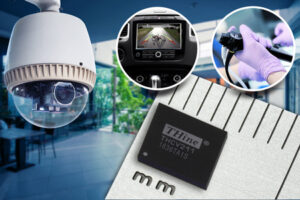 THine Electronics, Inc. (Tokyo Stock Exchange/JASDAQ: 6769), a semiconductor company focusing on high-speed serial interfaces, today announced an AEC-Q100 (Grade 2) compliant single-chip solution (THCV241-Q) that integrates the MIPI CSI-2 interface with THine’s well established V-by-One® HS product family.
THine Electronics, Inc. (Tokyo Stock Exchange/JASDAQ: 6769), a semiconductor company focusing on high-speed serial interfaces, today announced an AEC-Q100 (Grade 2) compliant single-chip solution (THCV241-Q) that integrates the MIPI CSI-2 interface with THine’s well established V-by-One® HS product family.
The new THCV241-Q is optimized for advanced camera requirements including:
– High definition support (e.g., 1080p60, 4K2K)
– Uncompressed real-time, zero-latency video transmission
– 50x increase in maximum transmission distance – from 30cm to 15m
– 360-degree rotation at an affordable price point
– Lower BOM cost
– Smaller circuit boards for more compact designs, new product form factors and higher reliability
Because today’s high-resolution CMOS camera modules mainly use the MIPI CSI-2 protocol output for its high data rate, transmission distance is limited to about 30 cm. However, MIPI CSI-2 integrated in the THCV241-Q processor chip extends cable length to 15 meters for uncompressed 1080p60 video data via a shielded twisted pair or a single coaxial line. In cars, for example, a clear rear view image is available to any point inside the vehicle without compression-induced latency. High Dynamic Range image displays in vehicles achieve unparalleled clarity.
THine also offers various receiver chips that support 150MHz parallel output and Open LDI (LVDS) output for 2 Mega-Pixel images or 1080p60 and plans to develop more line-ups. In addition, because the THCV241-Q processor supports transmission through a Slip-ring, PTZ cameras do not need close proximity to the Application Processor. The THCV241-Q’s outstanding video transmission performance also reduces costs and camera system size restrictions. For example, compared with Open LDI (LVDS) transmission, THCV241-Q transmission requires only one-fourth as many expensive slip ring cores, for a 75% cost reduction in the internal interfaces of PTZ cameras
Samples are scheduled for release in December 2016. To speed time to market and reduce design expense, THCV241-Q design support will include Evaluation Boards, application notes, datasheets, etc. CEL and THine have established design support in North America as well as Japan and the rest of Asia.
Leave a Reply